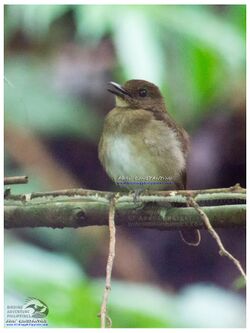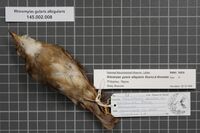Biology:White-throated jungle flycatcher
| White-throated jungle flycatcher | |
|---|---|

| |
| Scientific classification | |
| Domain: | Eukaryota |
| Kingdom: | Animalia |
| Phylum: | Chordata |
| Class: | Aves |
| Order: | Passeriformes |
| Family: | Muscicapidae |
| Genus: | Vauriella |
| Species: | V. albigularis
|
| Binomial name | |
| Vauriella albigularis (Bourns & Worcester, 1894)
| |
| Synonyms | |
|
Rhinomyias albigularis | |
The white-throated jungle flycatcher (Vauriella albigularis), also known as the Negros jungle flycatcher is a species of bird in the Old World flycatcher family Muscicapidae. It is endemic to the Philippines (Negros and Panay islands) and formerly on Guimaras before its extirpation there. The natural habitats of the white-throated jungle flycatcher are tropical moist lowland forests and tropical moist montane forests at altitudes of up to 1,350 meters.[2] It is threatened by habitat loss.
This species was previously placed in the genus Rhinomyias but was moved to Vauriella after a detailed molecular phylogenetic study published in 2010 found that Rhinomyias was polyphyletic.[3][4]
Description
EBird describes the bird as "A fairly small bird. Rufous-brown on the wings, back, and tail, with a gray head, heavily-streaked pale underparts, and a black face and moustache stripe. Often found in mixed-species flocks. Somewhat similar to Stripe-headed rhabdornis and Grand rhabdornis, but smaller, with a white eye-ring rather than a black band through the eye. Voice includes a loud rattling trill and various quiet chips and squeals."[5]
Habitat and conservation status
It is found in tropical moist lowland forests and the lower reaches of tropical moist montane forests typically below 1,000 meters above sea level, but has been recorded at up to 1,350 meters. It prefers primary forest but it has also been recorded in secondary forest and forest edge. It forages in the understorey and lower canopy usually below 10 meters above the ground.[2]
The IUCN Red List assessed this bird as endangered with population estimated as 2,500 to 10,000 mature individuals. It is mainly threatened by habitat loss. Negros is one of the most deforested islands in the country, owing to illegal logging and conversion of forests into sugarcane plantations. An estimated 4% of Negros and 8% of Panay remained forested in 1988, most of it above 1,000 m.
Conservation actions proposed include
- more surveys, especially on Panay, in order to fully understand the range and population of this bird
- stronger protection of remaining forest areas including securing funding to increase the number of forest rangers, as well as strengthening enforcement measures to prevent illegal logging.[6]
References
- ↑ BirdLife International (2016). "Vauriella albigularis". IUCN Red List of Threatened Species 2016: e.T22709182A94195238. doi:10.2305/IUCN.UK.2016-3.RLTS.T22709182A94195238.en. https://www.iucnredlist.org/species/22709182/94195238. Retrieved 12 November 2021.
- ↑ 2.0 2.1 Allen, Desmond (2020). Birds of the Philippines. Barcelona: Lynx and Birdlife International Fiedguides. pp. 326–327.
- ↑ Sangster, G.; Alström, P.; Forsmark, E.; Olsson, U. (2010). "Multi-locus phylogenetic analysis of Old World chats and flycatchers reveals extensive paraphyly at family, subfamily and genus level (Aves: Muscicapidae)". Molecular Phylogenetics and Evolution 57 (1): 380–392. doi:10.1016/j.ympev.2010.07.008. PMID 20656044.
- ↑ Gill, Frank; Donsker, David, eds. "Chats, Old World flycatchers". World Bird List Version 6.2. International Ornithologists' Union. http://www.worldbirdnames.org/bow/chats/.
- ↑ "Negros Jungle Flycatcher". https://ebird.org/species/negjuf1/.
- ↑ International), BirdLife International (BirdLife (2016-10-01). "IUCN Red List of Threatened Species: Vauriella albigularis". https://www.iucnredlist.org/en.
External links
Wikidata ☰ Q27075665 entry
 |



